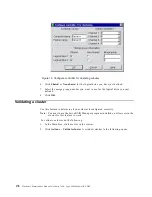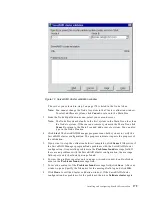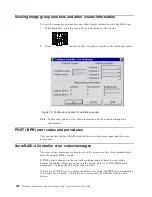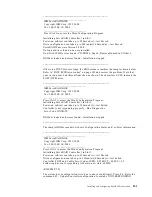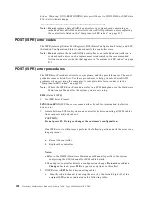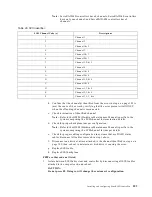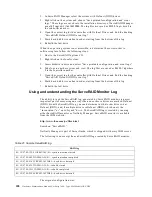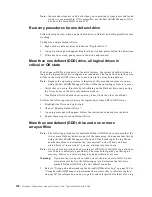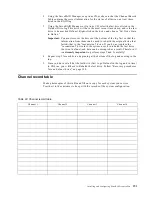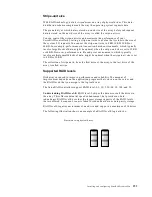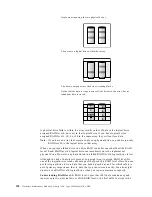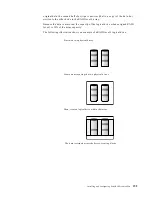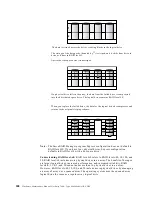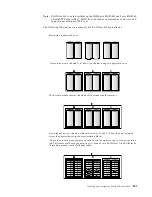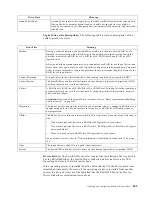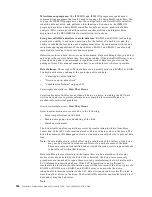
Installing and configuring ServeRAID controllers
189
•
SID 1: HSP
•
SID 2: ONL
•
SID 3: ONL
•
SID 4: ONL
The format is as follows:
date time error type: Ax Cx Bxx message
The x following A is the controller number; the x following C is the channel, and the
xx following B is the SID number. An error type can be either informational or critical.
The message gives a brief description of the RAID event that has occurred.
The first two lines of the ServeRAID log show that a synchronization was started and
proceeded to complete successfully. At a later point in time, on line 3 of the
ServeRAID log, a dead drive is detected on controller 1, channel 3, SID 3. In this case,
since an HSP drive is defined, the rebuild starts automatically. Both the start and
finish of the rebuild is logged by the controller. Later on, the drive in SID 4 is marked
dead, but no rebuild is started because the HSP drive has already been used.
In the current ServeRAID log, the drive in SID 4 is the “inconsistent” drive, and must
be physically replaced. If this is the case, you should mark other drives ONL and then
rebuild drive SID 4.
Note:
If the drive containing the operating system is not accessible see “Using
ServeRAID Manager to determine the correct order to software replace” on
page 187.
Before you perform any actions on the hardware, make a photocopy of the Channel
Record table, Table 22 on page 191. Use Netfinity Manager or ServeRAID monitor to
fill in the copy of the Channel Record table at the end of this manual with the current
status of all the drives, both internal and external. This table provides a four-channel
diagram to accommodate all types of ServeRAID controllers.
For the ServeRAID controllers, if power is lost or another drive is marked Defunct
(DDD) during a rebuild operation, the rebuild fails and the drive being rebuilt
remains in the Rebuild (RBL) state. Consequently, the “inconsistent” drive remains
recognizable.
Recovery from ServeRAID controller failure
When a ServeRAID controller fails, you must replace the ServeRAID controller and
then restore the ServeRAID configuration to the new ServeRAID controller. To restore
the ServeRAID configuration:
1.
Press CTRL+I during POST to enter the Mini-Configuration.
2.
Select Advanced Functions.
3.
Select Copy Configuration from Drives to Controller.
Recovery procedures
This section describes the recovery procedures for the following conditions:
•
“Recovery procedures for one defunct drive” on page 190
•
“More than one defunct (DDD) drive, all logical drives in critical or OK state” on
page 190
•
“More than one defunct (DDD) drive and one or more arrays offline” on page 190
Summary of Contents for 86655RY - Netfinity 7600 - 8665
Page 1: ...IBM Hardware Maintenance Manual Netfinity 7600 Type 8665 Models 1RY 2RY ...
Page 2: ......
Page 3: ...IBM Hardware Maintenance Manual Netfinity 7600 Type 8665 Models 1RY 2RY ...
Page 10: ...viii Hardware Maintenance Manual Netfinity 7600 Type 8665 Models 1RY 2RY ...
Page 52: ...42 Hardware Maintenance Manual Netfinity 7600 Type 8665 Models 1RY 2RY ...
Page 104: ...94 Hardware Maintenance Manual Netfinity 7600 Type 8665 Models 1RY 2RY ...
Page 148: ...138 Hardware Maintenance Manual Netfinity 7600 Type 8665 Models 1RY 2RY ...
Page 252: ...242 Hardware Maintenance Manual Netfinity 7600 Type 8665 Models 1RY 2RY ...
Page 270: ...260 Hardware Maintenance Manual Netfinity 7600 Type 8665 Models 1RY 2RY ...
Page 271: ...Related service information 261 ...
Page 272: ...262 Hardware Maintenance Manual Netfinity 7600 Type 8665 Models 1RY 2RY ...
Page 273: ...Related service information 263 ...
Page 274: ...264 Hardware Maintenance Manual Netfinity 7600 Type 8665 Models 1RY 2RY ...
Page 284: ...274 Hardware Maintenance Manual Netfinity 7600 Type 8665 Models 1RY 2RY ...
Page 285: ...Related service information 275 ...
Page 292: ...282 Hardware Maintenance Manual Netfinity 7600 Type 8665 Models 1RY 2RY ...
Page 293: ......




